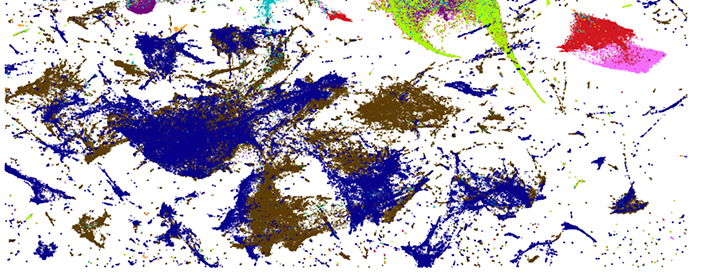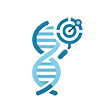
Our drug and target discovery tools utilize published Connectivity Mapping resources of transcriptomics and proteomics of chemical and genetic perturbations followed by expression to rank drugs and targets. These tools can be used to uncover relationships between drugs, targets, and diseases; identify MoAs for new drugs; and suggest targets for cell removal by antibody-drug conjugates (ADCs). These tools are designed to produce hypotheses for experimental validation. Users are expected to submit to these tools single genes, gene sets, and expression signatures to receive prioritized lists of drugs and targets.
Browse through the following categories to explore the various original resources we have developed:
Most Popular | Recently Published | Enrichment Analysis | Drug and Target Discovery | Computational Platforms and Workflow Engines | Gene and Drug Pages | lncRNAs | Data Portals | Data Visualization Components | Deprecated
sc2DAT
scRNA-seq 2 Drugs and Targets
Upload a single cell RNA-seq matrix or a bulk RNA-seq matrix with and select a corresponding single cell reference to identify cell-surface targets and LINCS L1000 compounds specific to automatically identified cell types.
PMID: 41079221
L2S2
LINCS L1000 Signatures Search Engine
As part of the LINCS initiative, 248 cell lines were profiled with the L1000 transcriptomics assay to measure the response to 33,621 small molecules and 7,508 single gene CRISPR knockouts (KOs). From this massive dataset, we computed sets of up- and down-regulated genes. These gene sets are served for search by the LINCS L1000 Signature Search (L2S2) platform. L2S2 provides instant results when searching across over 1.678 million chemical perturbations and CRISPR KO signatures. The platform includes filters for FDA-approved drugs and signature directionality. With the L2S2 search engine, users can identify small molecules and single gene CRISPR KOs that produce gene expression profiles similar or opposite to their submitted gene sets.
PMID: 40308216
SigCom LINCS
Data and Metadata Search Engine for a Million Gene Expression Signatures
SigCom LINCS is a webserver that serves over a million gene expression signatures processed, analyzed, and visualized from LINCS, GTEx, and GEO. SigCom LINCS is built with Signature Commons, a cloud-agnostic skeleton Data Commons with a focus on serving searchable signatures. SigCom LINCS provides a rapid signature similarity search for mimickers and reversers given sets of up and down genes, a gene set, a single gene, or any search term. Additionally, users of SigCom LINCS can perform a metadata search to find and analyze subsets of signatures and find information about genes and drugs. SigCom LINCS is findable, accessible, interoperable, and reusable (FAIR) with metadata linked to standard ontologies and vocabularies. In addition, all the data and signatures within SigCom LINCS are available via a well-documented API.
PMID: 35524556
Multiomics2Targets
Identifies Targets from Cancer Cohorts Profiled with Transcriptomics, Proteomics, and Phosphoproteomics
Multiomics2Targets is a platform that enables users to upload transcriptomics, proteomics, and/or phosphoproteomics data matrices from a matching cohort of cancer patients to receive a complete data analysis report that resembles a research publication.
PMID: 39127042
TargetRanger
Tool to Identify Cell Surface Immunotherapeutic Targets
TargetRanger is a web server application that identifies targets from user-inputted RNA-seq samples collected from the cells they wish to target. By comparing the inputted samples with processed RNA-seq and proteomics data from several atlases, TargetRanger identifies genes that are highly expressed in the target cells while lowly expressed across normal human cell types, tissues, and cell lines.
PMID: 37166966
Drug Gene Budger
Identify Drugs and Small Molecules to Regulate Expression of Target Genes
Drug Gene Budger (DGB) is a web-based and mobile application developed to assist investigators in order to prioritize small molecules that are predicted to maximally influence the expression of their target gene of interest. With DGB, users can enter a gene symbol along with the wish to upregulate or downregulate its expression. The output of the application is a ranked list of small molecules that have been experimentally determined to produce the desired expression effect. The table includes log-transformed fold change, p-value and q-value for each small molecule, reporting the significance of differential expression as determined by the limma method.
PMID: 30169739
L1000CDS2
L1000 Characteristic Direction Signature Search Engine
Finds consensus signatures that match users’ input gene lists or input signatures. The underlying dataset is the LINCS L1000 small molecule expression profiles generated at the Broad Institute by the Connectivity Map team. The differentially expressed (DE) genes of these profiles were calculated using the Characteristic Direction method.
PMID: 28413689
L1000FWD
Large-scale Visualization of Drug-induced Transcriptomic Signatures
L1000 fireworks display (L1000FWD) is a web application that provides interactive visualization of over 16,000 drug and small-molecule induced gene expression signatures. L1000FWD enables coloring of signatures by different attributes such as cell type, time point, concentration, as well as drug attributes such as MOA and clinical phase. Signature similarity search is implemented to enable the search for mimicking or opposing signatures given as input of up and down gene sets. Each point on the L1000FWD interactive map is linked to a signature landing page, which provides multifaceted knowledge from various sources about the signature and the drug. Notably such information includes most frequent diagnoses, co-prescribed drugs and age distribution of prescriptions as extracted from the Mount Sinai Health System electronic medical records (EMR). Overall, L1000FWD serves as a platform for identifying functions for novel small molecules using unsupervised clustering, as well as for exploring drug MOA.
PMID: 29420694
eXpression2Kinases Web
Linking Expression Signatures to Upstream Cell Signaling Networks
X2K Web infers upstream regulatory networks from signatures of differentially expressed genes. By combining transcription factor enrichment analysis, protein-protein interaction network expansion, with kinase enrichment analysis, X2K Web produces inferred networks of transcription factors, proteins, and kinases predicted to regulate the expression of the inputted gene list. X2K Web provides the results as tables and interactive vector graphic figures that can be readily embedded within publications.
PMID: 29800326
SEP L1000
Side Effect Prediction Based on L1000 Data
Serves the results of the predicted ADRs for the drugs and small-molecule compounds profiled in the LINCS L1000 project. A network of predictive ADRs was constructed based on their drug similarity and visualized using a stacked bubble chart. Each drug and ADR has a dedicated page with a list of the relevant predictions and external links.
PMID: 27153606
CREEDS
Crowd Extracted Expression of Differential Signatures
Collections of processed gene, drug and disease signatures from GEO.
PMID: 27667448










